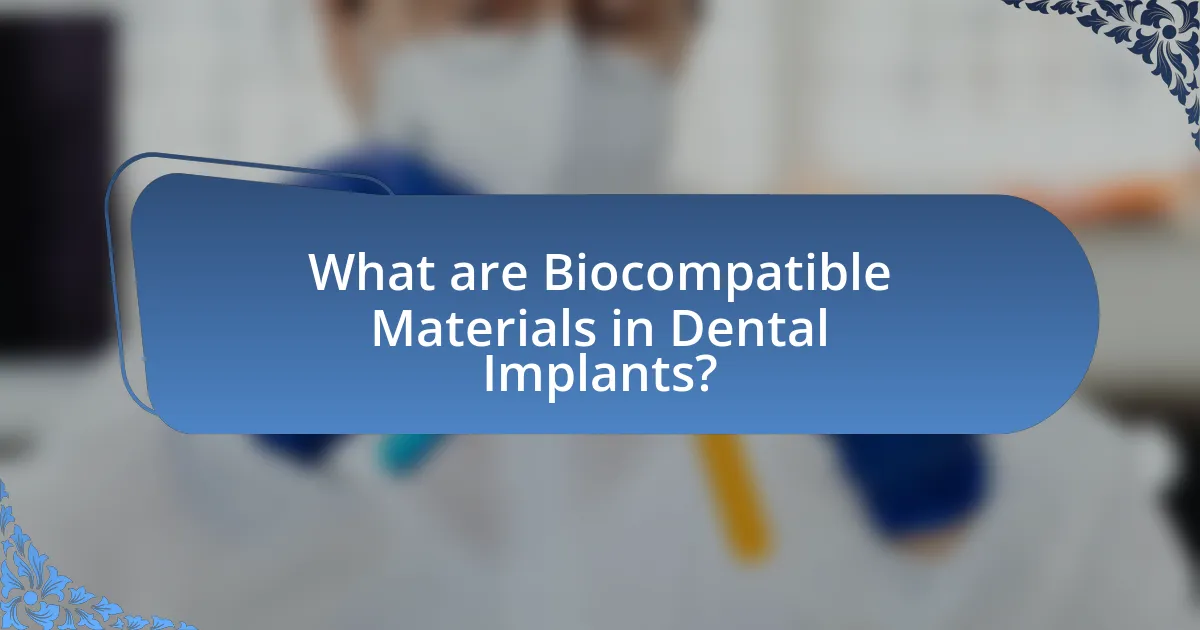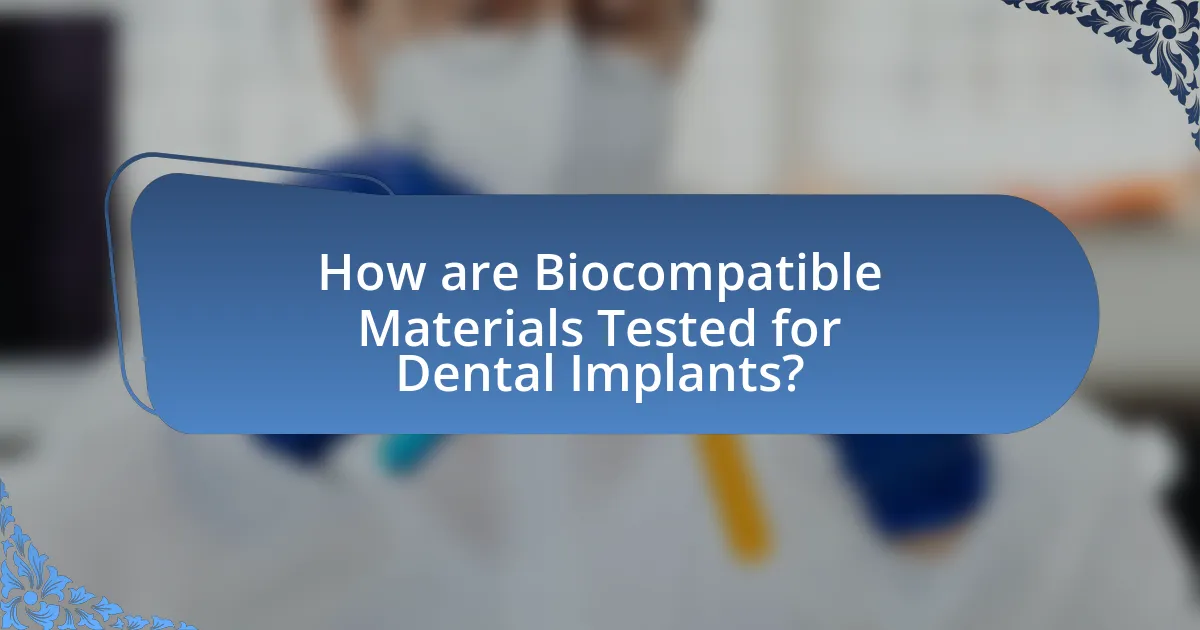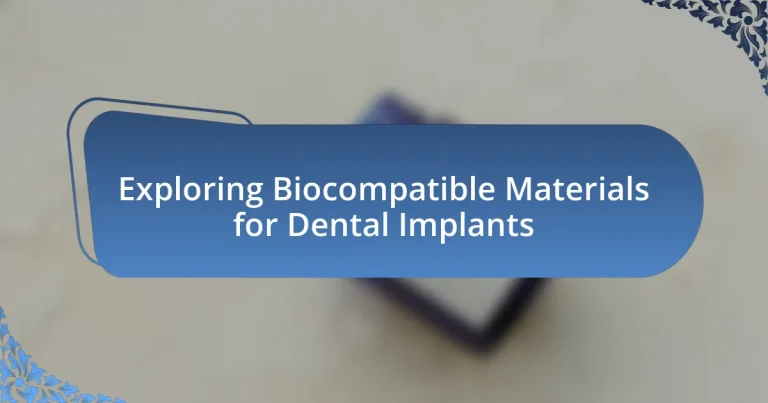Biocompatible materials in dental implants are essential substances that interact favorably with human tissue, minimizing immune responses and promoting successful integration with bone. This article explores the significance of biocompatibility in dental implants, highlighting materials such as titanium and zirconia, which are known for their mechanical strength and aesthetic qualities. It discusses the factors influencing biocompatibility, the testing methods used to evaluate materials, and the emerging innovations in the field, including advancements in nanotechnology and 3D printing. Additionally, the article addresses the challenges in testing these materials and outlines best practices for selecting suitable options for dental applications.

What are Biocompatible Materials in Dental Implants?
Biocompatible materials in dental implants are substances that are compatible with human tissue and do not provoke an immune response. Common examples include titanium, which is widely used due to its excellent strength-to-weight ratio and corrosion resistance, and zirconia, known for its aesthetic qualities and biocompatibility. Studies have shown that titanium implants integrate well with bone, achieving osseointegration, which is crucial for the stability and longevity of dental implants. According to a systematic review published in the Journal of Oral Implantology, titanium has a success rate exceeding 95% over a 10-year period, demonstrating its effectiveness as a biocompatible material in dental applications.
Why is biocompatibility important for dental implants?
Biocompatibility is crucial for dental implants because it ensures that the materials used do not provoke an adverse immune response in the body. When dental implants are biocompatible, they integrate well with the surrounding bone and soft tissue, promoting stability and longevity of the implant. Studies have shown that materials like titanium exhibit high biocompatibility, leading to successful osseointegration rates exceeding 95% in clinical settings. This integration is essential for the functionality and durability of dental implants, as it minimizes the risk of complications such as infection or implant failure.
What factors determine the biocompatibility of materials?
The biocompatibility of materials is determined by factors such as chemical composition, surface properties, mechanical properties, and biological response. Chemical composition influences how materials interact with biological tissues; for instance, materials that release toxic ions can provoke adverse reactions. Surface properties, including roughness and hydrophilicity, affect protein adsorption and cell attachment, which are critical for integration with host tissues. Mechanical properties, such as strength and elasticity, must match those of the surrounding tissues to prevent stress shielding or failure. Lastly, the biological response encompasses the immune reaction and tissue healing processes, which can vary based on the material’s characteristics. Studies have shown that materials like titanium exhibit favorable biocompatibility due to their optimal combination of these factors, leading to successful dental implant outcomes.
How does biocompatibility affect patient outcomes?
Biocompatibility significantly affects patient outcomes by determining how well a material interacts with biological tissues without eliciting adverse reactions. When dental implants are made from biocompatible materials, they promote better integration with the surrounding bone and soft tissue, leading to improved stability and longevity of the implant. Studies have shown that implants with high biocompatibility result in lower rates of inflammation and infection, which are critical factors in the success of dental procedures. For instance, research published in the Journal of Biomedical Materials Research indicates that titanium, a widely used biocompatible material, exhibits excellent osseointegration properties, enhancing patient satisfaction and reducing the likelihood of implant failure.
What types of materials are considered biocompatible for dental implants?
Biocompatible materials for dental implants primarily include titanium, zirconia, and certain polymers. Titanium is widely used due to its excellent biocompatibility, strength, and ability to osseointegrate with bone, which has been supported by numerous studies demonstrating its effectiveness in dental applications. Zirconia, a ceramic material, is also recognized for its aesthetic qualities and biocompatibility, making it suitable for patients with metal allergies. Additionally, specific polymers, such as polyetheretherketone (PEEK), are being explored for their favorable mechanical properties and compatibility with biological tissues. These materials have been validated through clinical research and trials, confirming their safety and efficacy in dental implant procedures.
What are the most commonly used biocompatible materials?
The most commonly used biocompatible materials include titanium, zirconia, and various polymers such as polyethylene and polylactic acid. Titanium is favored for its excellent strength-to-weight ratio and corrosion resistance, making it ideal for dental implants. Zirconia offers aesthetic advantages due to its tooth-like color and is also highly biocompatible. Polyethylene and polylactic acid are utilized for their flexibility and ease of processing, contributing to their application in various dental and medical devices. These materials have been extensively studied and validated for their compatibility with human tissues, ensuring minimal adverse reactions when used in dental implants.
How do these materials compare in terms of performance?
Biocompatible materials for dental implants, such as titanium, zirconia, and polymer-based composites, exhibit varying performance characteristics. Titanium is known for its excellent mechanical strength and osseointegration properties, making it the gold standard in dental implants, with a success rate exceeding 95% over ten years. Zirconia, while aesthetically superior and resistant to corrosion, has lower tensile strength compared to titanium, which can affect its long-term stability. Polymer-based composites offer flexibility and lower weight but generally lack the mechanical strength and durability of titanium and zirconia, leading to a higher failure rate in load-bearing applications. These performance differences are critical in selecting the appropriate material for specific clinical scenarios in dental implantology.

How are Biocompatible Materials Tested for Dental Implants?
Biocompatible materials for dental implants are tested through a series of in vitro and in vivo evaluations to assess their compatibility with biological tissues. In vitro tests typically include cytotoxicity assays, where the materials are exposed to cultured cells to determine any harmful effects, and biocompatibility tests that evaluate cell adhesion, proliferation, and differentiation. In vivo testing involves implanting the materials in animal models to observe tissue response, integration, and long-term stability. Regulatory bodies, such as the FDA, require these comprehensive assessments to ensure that the materials do not elicit adverse reactions and promote osseointegration, which is critical for the success of dental implants.
What testing methods are used to evaluate biocompatibility?
Testing methods used to evaluate biocompatibility include in vitro assays, in vivo studies, and cytotoxicity tests. In vitro assays assess cellular responses to materials, such as cell adhesion, proliferation, and differentiation, providing initial insights into biocompatibility. In vivo studies involve implanting materials in animal models to observe biological responses, including inflammation and tissue integration, which are critical for understanding long-term effects. Cytotoxicity tests specifically measure the toxic effects of materials on cultured cells, ensuring that materials do not harm surrounding tissues. These methods are standardized by organizations like ISO and ASTM, ensuring reliability and reproducibility in biocompatibility assessments.
What are in vitro and in vivo testing methods?
In vitro testing methods involve experiments conducted outside of a living organism, typically in controlled laboratory environments using cells or biological molecules. These methods allow researchers to study biological processes, drug interactions, and material properties in a simplified setting, providing insights into the biocompatibility of materials intended for dental implants. In contrast, in vivo testing methods are performed within living organisms, allowing for the assessment of the biological response to materials in a complex biological system. This approach is crucial for evaluating the safety and effectiveness of dental implants in real physiological conditions. Both testing methods are essential in the development and validation of biocompatible materials for dental applications, ensuring that they meet necessary safety and efficacy standards.
How do regulatory standards influence testing procedures?
Regulatory standards significantly influence testing procedures by establishing specific criteria that materials must meet to ensure safety and efficacy. For instance, the ISO 10993 standard outlines the biological evaluation of medical devices, including dental implants, mandating rigorous testing for biocompatibility. Compliance with these standards ensures that testing procedures are systematic, reproducible, and aligned with international safety benchmarks, thereby reducing the risk of adverse reactions in patients.
What challenges exist in testing biocompatible materials?
Testing biocompatible materials presents several challenges, primarily due to the complexity of biological interactions and the variability in individual responses. One significant challenge is the need for standardized testing protocols that accurately reflect in vivo conditions, as many existing methods do not fully replicate the human biological environment. Additionally, the assessment of long-term biocompatibility is difficult, as it requires extensive timeframes to observe potential adverse reactions or degradation of materials. Furthermore, the variability in biological responses among different individuals complicates the interpretation of results, making it challenging to establish universally applicable safety standards. These factors collectively hinder the development and regulatory approval of new biocompatible materials for applications such as dental implants.
What are the limitations of current testing methods?
Current testing methods for biocompatible materials in dental implants face several limitations, including a lack of standardized protocols, which can lead to inconsistent results across studies. Additionally, many existing methods do not adequately simulate the complex biological environment of the human body, resulting in data that may not accurately predict in vivo performance. For instance, in vitro tests often fail to account for the dynamic interactions between the implant material and biological tissues, which can affect osseointegration and overall success rates. Furthermore, current testing methods may not fully assess long-term biocompatibility, as many studies are conducted over short time frames, limiting the understanding of material behavior over extended periods.
How can these challenges be addressed in future research?
Future research can address challenges in exploring biocompatible materials for dental implants by focusing on the development of advanced materials that enhance osseointegration and reduce rejection rates. For instance, studies can investigate the use of bioactive glass and titanium alloys that promote bone growth and integration, as evidenced by research showing that bioactive glass can significantly improve bone bonding (Hench, 1998, Journal of Biomedical Materials Research). Additionally, incorporating nanotechnology to modify surface properties of implants can enhance biocompatibility and mechanical strength, as demonstrated in recent studies where nanoscale surface modifications led to improved cell adhesion and proliferation (Zhang et al., 2020, Materials Science and Engineering). By prioritizing these innovative approaches, future research can effectively overcome existing limitations in dental implant materials.

What Innovations are Emerging in Biocompatible Materials for Dental Implants?
Innovations in biocompatible materials for dental implants include the development of bioactive glass, titanium alloys with enhanced surface properties, and polymer-based composites. Bioactive glass promotes bone regeneration and integrates well with surrounding tissues, as evidenced by studies showing improved osseointegration rates. Titanium alloys, such as Ti-6Al-4V, are being modified with surface treatments like plasma spraying and anodization to enhance their biocompatibility and mechanical strength. Additionally, polymer-based composites, which combine polymers with bioactive fillers, are being explored for their potential to reduce inflammation and improve patient comfort. These advancements are supported by ongoing research demonstrating their effectiveness in clinical applications.
How are new technologies shaping the development of biocompatible materials?
New technologies are significantly advancing the development of biocompatible materials by enabling the creation of more effective and tailored solutions for dental implants. Innovations such as 3D printing allow for precise customization of implant shapes and sizes, enhancing integration with bone tissue. Additionally, advancements in nanotechnology facilitate the incorporation of bioactive compounds into materials, promoting better osseointegration and reducing the risk of rejection. Research has shown that materials engineered at the nanoscale can improve mechanical properties and biological responses, as evidenced by studies demonstrating enhanced cell adhesion and proliferation on nanostructured surfaces. These technological advancements are crucial in addressing the challenges of biocompatibility and functionality in dental implant applications.
What role do nanomaterials play in enhancing biocompatibility?
Nanomaterials significantly enhance biocompatibility by improving the interaction between implants and biological tissues. Their unique properties, such as increased surface area and tailored chemical functionalities, facilitate better cell adhesion, proliferation, and differentiation. For instance, studies have shown that titanium dioxide nanoparticles can promote osteoblast activity, leading to improved bone integration in dental implants. Additionally, the incorporation of nanomaterials can reduce inflammatory responses, as evidenced by research indicating that nanoscale coatings can modulate immune cell behavior, thereby enhancing the overall acceptance of implants in the body.
How is 3D printing impacting the creation of dental implants?
3D printing is revolutionizing the creation of dental implants by enabling the production of highly customized and precise implant designs. This technology allows for the rapid prototyping of implants tailored to the unique anatomical features of individual patients, which enhances fit and comfort. Additionally, 3D printing facilitates the use of advanced biocompatible materials, such as titanium and certain polymers, which improve the integration of implants with bone tissue. Studies have shown that 3D-printed implants can achieve better osseointegration rates compared to traditional methods, leading to improved patient outcomes.
What future trends can we expect in biocompatible materials for dental implants?
Future trends in biocompatible materials for dental implants include the development of advanced ceramics, bioactive glass, and polymer-based composites that enhance osseointegration and reduce inflammation. Research indicates that materials like zirconia and hydroxyapatite are gaining traction due to their superior mechanical properties and biocompatibility, as evidenced by studies showing improved integration with bone tissue. Additionally, the incorporation of nanotechnology is expected to enhance the surface properties of implants, promoting better cell adhesion and proliferation, which is supported by findings in recent publications on nanostructured materials.
What advancements are being made in material science?
Advancements in material science, particularly in the context of biocompatible materials for dental implants, include the development of novel biomaterials that enhance osseointegration and reduce rejection rates. Recent research has focused on using bioactive glass and titanium alloys that promote bone growth and integration with surrounding tissues. For instance, studies have shown that bioactive glass can stimulate osteoblast activity, leading to improved healing times and implant success rates. Additionally, advancements in 3D printing technology allow for the customization of implant shapes and sizes, further improving compatibility with individual patient anatomy. These innovations are supported by clinical trials demonstrating higher success rates and lower complication rates associated with these new materials.
How might patient-specific implants change the landscape?
Patient-specific implants could revolutionize the landscape of dental procedures by enhancing the fit and functionality of implants tailored to individual anatomical needs. This customization leads to improved patient outcomes, as studies indicate that personalized implants can reduce complications and increase the longevity of dental restorations. For instance, research published in the Journal of Prosthetic Dentistry highlights that patient-specific implants significantly improve the integration with surrounding bone and soft tissue, resulting in better overall oral health and satisfaction.
What best practices should be followed when selecting biocompatible materials for dental implants?
When selecting biocompatible materials for dental implants, it is essential to prioritize materials that exhibit high biocompatibility, mechanical strength, and corrosion resistance. Biocompatibility ensures that the material does not provoke an adverse immune response, which is critical for the long-term success of the implant. Materials such as titanium and its alloys are widely recognized for their excellent biocompatibility and mechanical properties, as evidenced by numerous studies demonstrating their effectiveness in osseointegration, where the bone integrates with the implant surface. Additionally, it is important to consider the surface properties of the materials, as roughened surfaces can enhance bone attachment and promote faster healing. Research indicates that surface modifications, such as coatings or treatments, can significantly improve the biological response of the implant. Furthermore, evaluating the long-term stability and degradation behavior of the materials in the oral environment is crucial, as this impacts the durability and longevity of the implant.

